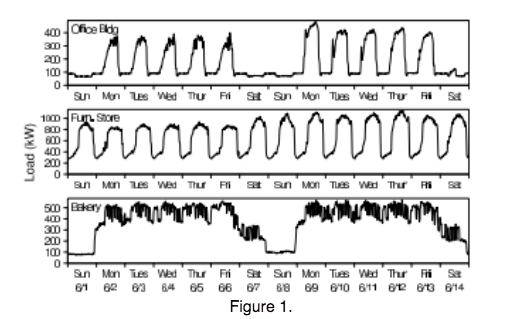|
Week Sixteen CalTRACK Update  During the standing meeting on 5/24, the working group finalized hourly methods for calculating hourly energy savings and commenced discussion on aggregating hourly savings into portfolio loadshapes. The finalized hourly methods and an introduction on aggregating portfolio loadshapes are outlined below. Finalized Hourly Methods:
Aggregating Hourly Savings into Portfolio Loadshapes
To provide an accurate valuation of energy efficiency as a grid resource, energy savings must be quantified at specified time intervals and geographic locations. To create portfolio loadshapes, building-level savings must be aggregated. The method of aggregation has implications on the portfolio uncertainty and provides different granularity of information for aggregators, utilities, and customers. Different use cases may prefer different aggregation methods based on priorities specific to their use case. To accommodate different use cases, flexible methods for aggregating hourly savings into portfolio loadshapes may be preferred. As we explore this topic further, some potential use cases to consider are: Pay-for-Performance Programs In the PG&E pay-for-performance program, the utility provides incentives for peak savings. This requires estimates of portfolio savings at the hourly level. Non-Wires-Alternative Procurement Non-Wireless-Alternative procurements require estimates of portfolio savings for buildings connected to specific grid nodes in order to measure grid impacts and potentially avoid infrastructure investments. Cap and Trade, Greenhouse Gases, or Carbon Tracking or Trading Initiatives Initiatives attempting to accurately quantify carbon offsets from energy efficiency investments require savings estimates at specified time and geographic locations because generation portfolios utilize resources with different carbon intensity at different times and locations. We discussed a few options for aggregation methods, and look forward to input from the working group in the coming week.
1 Comment
Week Fourteen & Fifteen CalTRACK Update Review of hourly method proposals continued in week fourteen of CalTRACK 2.0 and will be finalized at the 5/24 working group meeting. Lawrence Berkeley National Lab’s Time-of-Week Temperature (TOWT) model is the specification to be used in CalTRACK 2.0. Mathieu et al. describe the application of TOWT models in Quantifying Changes in Building Electricity Use, with Application to Demand Response. Overview of TOWT models: As energy efficiency finds its legs as a grid resource, time dependent savings will be essential to the value proposition. Pay-for-performance programs can leverage this value with accurate building-level energy savings calculations at granular time intervals. TOWT models are one method for calculating energy savings at the hourly level. Strengths:
Weaknesses:
Week Thirteen Update for CalTRACK  During week thirteen, the CalTRACK working group discussed proposals for hourly methods in the standing meeting. The discussions included helpful suggestions of other reference materials as well as variations that may be appropriate for different applications of hourly methods and suggested improvements in CalTRACK 2.0’s documentation. The video from May 3, 2018 is provided at the end of this post. Hourly Methods In the development of hourly methods, the goal is to establish guidelines that mirror the methodology in billing period and daily methods. However, hourly methods have unique complexities that require departures from billing period and daily methods. These complexities are identified and discussed below: Data Management When compared to hourly data, daily and billing period savings calculations have higher data sufficiency requirements because hourly data contains more information per time period. This characteristic of hourly data supports the two adjustments to hourly data sufficiency requirements listed below: 1. Usage data sufficiency will be specified in terms of data coverage (or common support) instead of a minimum time period: Daily and billing period data sufficiency requirements impose a minimum quantity of time observed from a year of data. In hourly methods, usage data sufficiency will be specified in terms of data coverage in the independent variables. In Time of Week and Temperature (TOWT) models, the independent variables are temperature and occupancy. Data sufficiency requirements will be based on LBNL recommendations for data coverage. 2. Missing Data Temperature has less variation between hours than days or billing periods. Smaller temperature variation between hours increases the likelihood that interpolated temperature values are accurate. For this reason, interpolated temperature values will be allowed in the reporting period for hourly methods. The threshold of allowable interpolated hours will be determined through empirical testing. Recommendation for Pay-for-Performance Use Case:
Time Of Week Temperature (TOWT) Modeling Approach The TOWT model, originally by Lawrence Berkeley Lab, contains two covariates: Occupancy: Occupancy is an indicator variable that takes the value of 1 if the building is occupied in the hour and 0 otherwise. In LBNL’s model, occupancy of a building is defined by:
The TOWT model allows user-defined temperature bins for modeling a building’s weather dependence. We are recommending setting 7 fixed bins with endpoints at 30, 45, 55, 65, 75, 90, in order to cover a wide variety of climate conditions. Use Case and Uncertainty Time-aggregated Uncertainty: In the program evaluation use case, an analyst may be interested in obtaining time-aggregated savings and uncertainty. Due to residual autocorrelation at the hourly level, aggregating hourly uncertainty for larger time intervals creates imprecise standard errors and uncertainty calculations. Instead, we recommend using daily methods with improved ASHRAE or Ordinary Least Squares (OLS) formulations of Fractional Savings Uncertainty (see Koran 2017) for aggregating uncertainty over time periods. Hour-level Uncertainty Estimates: For the procurement and pay-for-performance use cases, regression analysis is an effective tool for acquiring point estimates of savings and uncertainty at each hour. If each building is assumed to have independent errors, the uncertainty at each hour for all buildings in the portfolio can be aggregated without an autocorrelation problem. Methods Documentation Currently, the documentation for CalTRACK 2.0 is being updated. The first half of CalTRACK 2.0’s documentation will be posted on GitHub to allow the working group to review and comment on the changes in documentation. Similar to the methods, the development of effective documentation is an iterative process. The documentation for CalTRACK 2.0 will improve by dividing into three distinct documents: 1. Methods This document outlines the methodology for quantifying billing period, daily, and hourly energy savings while maintaining CalTRACK-compliancy. In CalTRACK 2.0, the Methods will be organized with a numbering system that corresponds to the Methodological Appendix. This will make referencing and accessing the appendix easier. 2. Methodological Appendix The Methodological Appendix summarizes discussions and empirical testing that justify methodological decisions. The Methods will reference sections in the Methodological Appendix for readers to easily access empirical support for methodological decisions. 3. Field Guide A document with minimum requirements for an implementation to maintain CalTRACK-compliancy. This is designed to be a practical and accessible checklist for analysts and other implementers of CalTRACK. Ideas for Future CalTRACK Work A sandbox has been added to the GitHub site to document proposals for participants to add ideas for future CalTRACK iterations. If you have an idea for CalTRACK 3.0, or beyond that cannot be addressed this year, please add it the the sandbox. Additional Hourly Methods Resources
Homework |
The purpose of this blog is to provide a high-level overview of CalTrack progress.
For a deeper understanding or to provide input on technical aspects of CalTrack, refer to the GitHub issues page (https://github.com/CalTRACK-2/caltrack/issues). Recordings
2019 CalTRACK Kick Off:
CalTRACK 2.0 July 19, 2018 June 28, 2018 June 7, 2018 May 24, 2018 May 3, 2018 April 12, 2018 March 29, 2018 March 15, 2018 March 1, 2018 February 15, 2018 February 1, 2018 Archives
March 2024
|


 RSS Feed
RSS Feed
